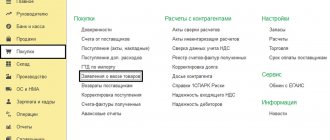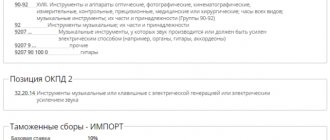What mistakes do declarants most often make?
The most obvious mistake that should not be made is moving prohibited goods across the border. Their list is regulated by the decision of the Board of the Eurasian Economic Commission dated April 21, 2015 No. 30 “On non-tariff regulation measures.”
In addition, special economic measures, which are popularly called simply “sanctions,” continue to be in effect. These prohibitions are regulated by several Presidential decrees and Government resolutions.
Now let's figure out what errors most often appear when registering cargo at customs.
Incorrect HS code
The HS code determines several important parameters for cargo registration: the amount of duty, the VAT rate, the required set of documents, the need for certification.
Therefore, the inspector will carefully check whether the code is selected correctly. If in doubt, it is better to seek help from a customs broker: for 1000 rubles. Meridian will select the correct code in two hours.
An example of an error: You are preparing a batch of electric garlands for the New Year worth 1,000,000 rubles. Open the list of HS codes and find the code 9505109000 - “New Year's products”, duty 8%. It seems suitable - we can declare it. But there is an exception to this code - electrical garlands of all types are not included.
They fall under a different code - 9405300001, where the duty is 15% and certification is required. If you declare such a product under the 95th group of codes, then the customs office will initiate an administrative violation case due to understatement of payments.
Let's calculate unplanned expenses:
- The duty increased by 70,000 rubles;
- Customs fine: from 35,000 to 140,000 rubles;
- According to the new code, a certificate of conformity will be required: with the import of samples it is about 130,000 rubles;
- While you are issuing the certificate, the goods will remain in a temporary storage warehouse, this can take up to 21 days at an average warehouse price of 1,000 rubles per day, which turns out to be 21,000 rubles.
Total: 256,000 rubles of unplanned expenses and every chance of not being able to deliver the goods in time for the season.
Not a “pass” price
The duty is calculated based not only on the rate according to the HS code, but also on the customs value declared in the declaration. Customs has the concept of a “gateway” price, which is formed statistically based on data on other similar cargo. If the specified price for the goods is lower than the “gate price”, then the inspector may adjust the customs value (CTV) upward. If the price is too high, customs may suspect that currency is being transferred abroad in this way.
Example: A company bought an ice cream production machine in Italy for 2000 euros, this price was stated in the declaration. During the inspection, the inspector had doubts; he went to the manufacturer’s official website and saw there the cost of the machine at 4,500 euros. The company was asked to confirm exactly how they managed to buy the product at such a low price.
The customs demanded that the arguments that the supplier gave a wholesale discount be confirmed with documents. But there were no such documents: the supplier did not provide price lists and no contracts were concluded; the company bought the goods on an invoice. As a result, customs more than doubled the duty.
Didn't collect the necessary documentation
In our practice, more than 90% of cargo is released without inspection if everything is in order with the package of documents. But if you do not clarify in advance what documents are required by the HS code and the name of your product, customs will not issue a declaration. Here is a case from the practice of a familiar company that was let down by its previous broker.
Example: A company imported terry towels, which also required a certificate. The broker said nothing about this, and the clients themselves did not clarify. As a result, the declaration is submitted without a certificate and the inspector refuses to issue it. It was necessary to first import samples, obtain a certificate for them from a special certification body, and only then transport the main batch.
Incorrect labeling
From July 1, 2021, new rules for electronic labeling of goods will gradually come into force. By the end of the year, it will no longer be possible to import medicines, tobacco, shoes, perfumes, cameras, tires and tyres. An experienced broker, even before submitting the declaration, requests an inspection (not an inspection!) of the consignment of goods to ensure that the labels are correct. In this case, all errors can be corrected even before customs clearance begins.
If, during inspection, the inspector discovers incorrectly issued labels or their insufficiency, the cargo will be detained and the importer will be required to relabel the entire consignment of goods. Moreover, it must be taken into account that this cannot be done at any customs terminal.
In addition, customs will initiate an administrative case and impose a fine of 50,000 rubles.
To prevent such cases from happening, experienced brokers resolve the labeling issue in advance. For example, we always prepare for the supplier a sample label, made in compliance with all customs requirements, and clear instructions on where to stick it all.
Premarket. Risk limits are lower
Japanese Nikkei (-0.3%) Chinese Shanghai Composite (+1.3%) South Korean Kospi (+0.5%) Hong Kong Hang Seng (+1.1%) Australian ASX (-0.3%)
The main thing
US and Asian markets continue to discount the risks of the new Omicron strain, rising for the third session in a row. Commodity markets are also optimistic as the threat of a fall in commodity demand due to likely socio-economic restrictions has subsided. The background before the opening of Europe is calm. At the start of the day, the indices may turn light green, but there is also a Russian factor.
At the same time, the reversal of the monetary policy of central banks restrains the growth of stock markets. The Central Bank of Brazil, the eighth economy in the world in terms of purchasing power parity, again raises the key rate by 150 bp, to 9.25% per annum. In all likelihood, the Central Bank of the Russian Federation will act in a similar way next week, but in smaller increments. And next Wednesday, market participants expect a compression of the quantitative program from the Fed.
The rebound of Brent oil futures from December lows, under $66, exceeded 15% over the week, to $76.5. High volatility of contracts reflects the confrontation of fundamental factors. The focus is on the pandemic, stocks and reserves of raw materials, and the activity of oil producers. European gas prices also include a geopolitical driver.
Asian markets
The stock market of the largest economy is trying to reverse the medium-term negative sentiment.
The Chinese Shanghai Composite is consolidating above important levels that previously separated the bull zone from the bear zone, heading towards the highs of the year. The Chinese market still remains the weakest in the world - plus 6% for the composite and minus 7% for the blue chip benchmark (China A50) with +16% for the global ACWI.
However, the rise of the Shanghai Composite in recent days significantly improves the medium-term technical picture, pushing back the danger of an early descent. Previously, regulatory tightening in the IT sector and problems in China's construction sector were risk factors. The negativity has not gone away, but the monetary softness of the NBK provides timely support.
At the same time, the stimulating function of the country’s Central Bank does not help in any way to reduce price pressure in the economy. The inflation rate rose to a one-and-a-half-year high of 2.3%, while producer prices reached their highest level since 1995, at 12.9%. Investors, apparently, are not worried about this yet - market participants are counting on the mitigation of the energy crisis.
Thus, in the Asia-Pacific markets today the Celestial market sets the tone. The persistence of stock bulls is explained by the tough position of the country's Central Bank against the backdrop of massive non-payments in the real estate sector.
The Asian factor in the price of European securities on Thursday is still encouraging players to increase.
American sites
US indices continued to digest the risks of the mutating coronavirus. Positive assessments of the effectiveness of existing vaccines from global pharmaceutical companies have clearly encouraged investors.
The broad market benchmark S&P 500 closed above 4,700 points, almost completely erasing November's losses. Technically, the dominance of stock bulls will last until the index returns below the level of 4630 points. The pullback of morning futures to 4700 points does not yet look like a convincing argument for bearers, but it can still somewhat reduce the upward pressure in the overheated index for 3 days.
But arguments for a market correction may appear as early as next Wednesday. Once again, the indices are approaching highs for the last Fed meeting of the year. Estimates continue to lead to an accelerated tapering of the quantitative easing program, which also promises an earlier increase in the funding rate. The target for a complete cessation of QE is shifting to the beginning of the second quarter of 2022, at which time the zero rate of the Central Bank may move upward.
If you look at rate futures, the probabilities of holding and increasing the Fed's funding costs are almost equal. The focus is on the May meeting of the Open Market Committee.
Thus, another surge of American indices to their highs nullified the gains of stock bears. You will have to start all over again, but only after the signal has occurred, and not trying to catch the market high. The signal could be the S&P 500 consolidating at 4630 points; in terms of time, you can focus on the results of the Fed meeting next Wednesday.
But the geopolitical factor plays into the hands of Russian short sellers. Previously, medium-term estimates of the risk limit for the stock market in case of an unfavorable outcome were carried out. So far, the trajectory of the Moscow Exchange index completely fits into the weak technical picture. The modeling approach does not predict that the market will head significantly below observed lows, but statistical support for volatility should be kept in mind when making an investment decision.
Raw materials
Oil prices continue to rise. Today, February contracts reach $76.5 per barrel of Brent. The powerful wave of November's 25% decline is followed by an equally impressive 15% rebound. The volatility of the instrument remains expectedly very high, and the upward surge in Brent is considered temporary.
Factors in energy prices: the epidemiological picture, the dynamics of raw material production, the trajectory of reserves. First of all, oil bulls played the card of reduced fears about the new Omicron strain. The rise in European gas prices above $1,200 per thousand cubic meters can be attributed to the confrontation between Western countries and Russia, as the largest exporter.
However, the sellers are still on the side - increasing oil production in the United States to one-and-a-half-year highs, only a slight decrease in crude oil reserves against the market consensus of a significant drop in the indicator. And the forecasts of industry energy institutes are not as positive as they were before - a reassessment of the risk of commodities fading, which we clearly spoke about last quarter, is beginning.
Statistics from the US Department of Energy (EIA) confirmed our skepticism yesterday about the strong discrepancy in data from the American Petroleum Institute (API). Thus, the official indicator of weekly crude oil reserves decreased by only 240 thousand barrels, with a consensus of disposals of 1.7 million and API data of minus 3.1 million.
BCS World of Investments
What else could happen because of the error?
Can they take it away?
Confiscation of goods is another possible consequence of incorrect customs clearance. This measure is provided for many cases: provision of false information, attempts to conceal part of the shipment, unreliable documentation, violation of import procedures, etc. Until a court decision on confiscation is received, customs has the right to seize and detain the goods. If during this time all declaration issues are resolved, the cargo is returned to the carrier.
Are there criminal penalties?
The same violation can lead to both administrative and criminal liability. For example, when changing the HS code, the rate for calculating the duty changes upward. If the amount of lost customs payments exceeds 2 million rubles, then a criminal case is initiated. If the difference exceeds 6 million rubles, then this is recognized as evasion of payment on an especially large scale.
Risk characteristics
Risks contain factors that differ in the time or place of formation, the method of manifestation, and the degree of influence on the work of the organization. The result of their influence may be an unfavorable situation in the form of:
- lost (lost) profit;
- direct loss;
- lack of activity results;
- an event that could cause losses or loss of income in the future.
Types of enterprise risks are interrelated and interdependent. Changing one can affect others, increasing or decreasing their severity.
What are the risks associated with an organization's participation in joint ventures and associates?
Risks are characterized by the following concepts:
- Economic essence, connection with the economic activities of the enterprise, influence on the formation of profit.
- The probability of formation, manifested in the fact that in economic activity a negative event may or may not occur depending on a number of factors.
- Uncertainty of consequences, lack of pattern. In terms of the degree of risk, the consequences of the economic process can vary over a significant range, reflected in the form of material losses and in the formation of the revenue side.
- Expected adverse impact. The consequences of risks affect the results of the production process either positively or negatively, but they are usually assessed from the perspective of possible negative consequences. As a result of risks, loss of profit and capital itself is possible, which can lead to bankruptcy of the company in critical circumstances.
- Level variability, changeability due to the influence of factors that are in continuous dynamics.
- The subjectivity of the assessment, that is, its unequal value depending on a number of factors (reliability of information, completeness, qualifications of managers).
Tax risks of large agricultural enterprises.






